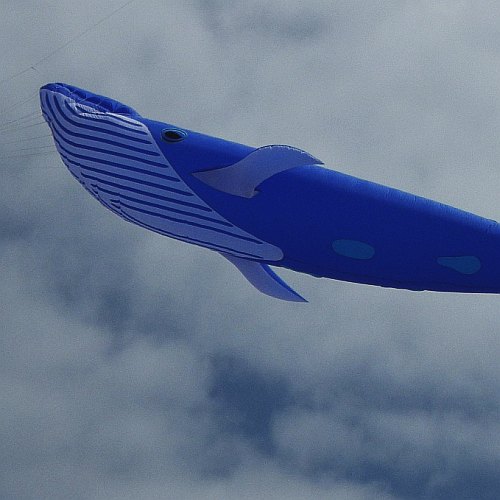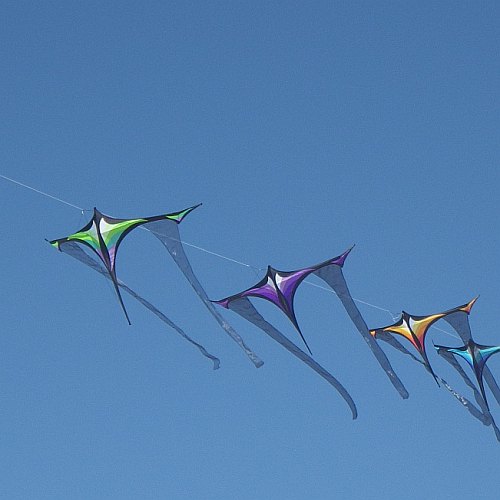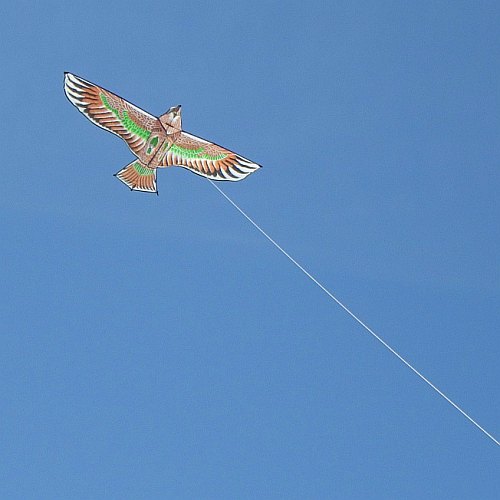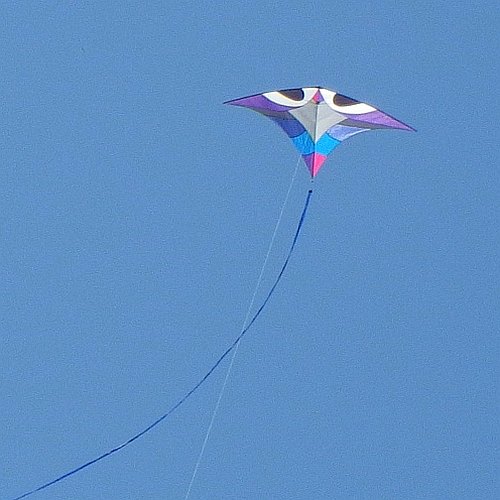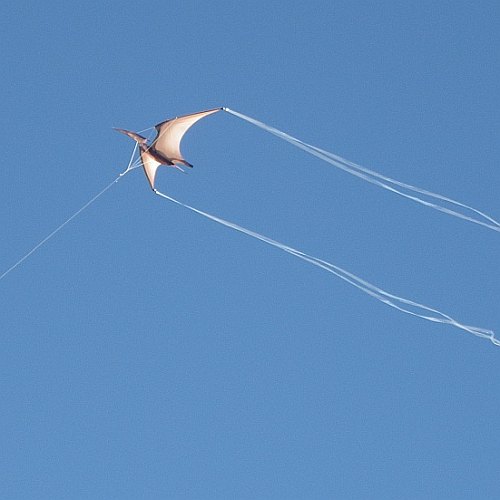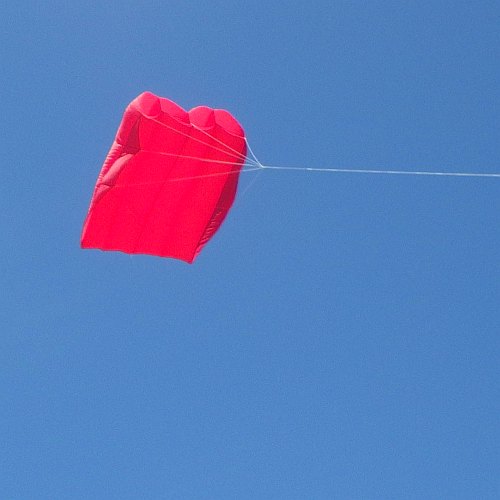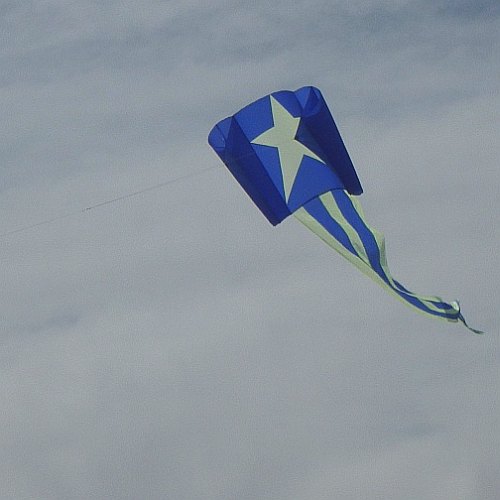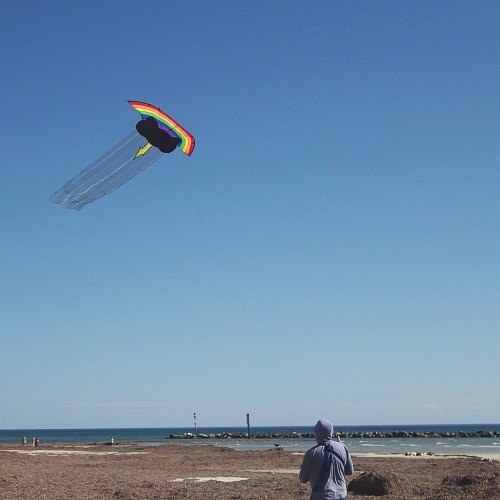AKFA Kite Fly Posts 2015
Adelaide Kite Flyers Association (AKFA). Every second Sunday of the month is a social fly day when (weather permitting) members meet to fly kites at Semaphore South.
These short flight reports once appeared in the site blog page although that blog is no longer being published. Just scroll down and stop at any kiting detail that appeals. :-) There's a photo gallery down near the bottom of this page too.
On this site, there's more kite-making info than you can poke a stick at. :-)
Want to know the most convenient way of using it all?
The Big MBK E-book Bundle is a collection of downloads—printable PDF files which provide step-by-step instructions for many kites large and small.
Every kite in every MBK series.
AKFA Kite Fly—December 2015
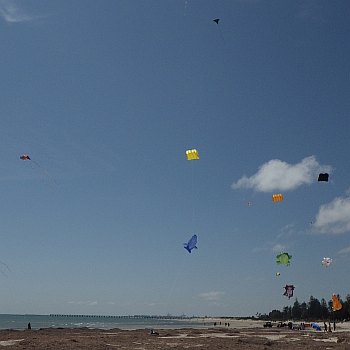 At the beach earlier in the year
At the beach earlier in the yearWarm weather and quite a lot of thin cloud cover persisted for most
of the afternoon. The breeze was almost southerly and remained in the gentle range the whole time we were there. A wind-meter
reading was 11 kph gusting to 16 kph, and it didn't vary a lot either up
or down from there. Just about anything will fly in that!
The
Multi-Fly Diamond train I put up sat fairly low at around 30 degrees. It
would have liked a few more kph. When carefully trimmed, these kites
will stay in the air in 40 kph gusts.
Other AKFA kites included
a sled with inflatable spars, a heart-shaped parafoil being flown on
the sled's line, a large white parafoil, two delta conynes, and a four-line
traction kite. There was even an inflatable monkey and tortoise by the
end of the session, being lifted by the big parafoil.
Also
enjoying the easy flying conditions were a small pterodactyl, a two-line
sport kite, a couple of ship kites, a small dopero kite, plus a few
others further away toward the water.
In general, all the
kites were uncharacteristically devoid of much motion. This was due to a
combination of very smooth air from across the water and fairly low wind speeds.
It all made for a very pleasant afternoon of flying
for those of us who turned up. That's not to mention the fliers closer to the
lapping water who were not associated with AKFA. Perhaps they got
enthused by seeing what happens down here every few weeks.
AKFA Kite Fly—November 2015
According to the forecast when I had last seen it, winds were expected to be in the gentle range—that is, between about 12 and 20 kph. Pretty ideal! However, it turned out to be much lighter. Never mind. Three AKFA optimists, including yours truly, turned up.
On stepping out of
the car and hearing how marginal the breeze had been for some time, I
instantly regretted not taking along an extremely light-wind diamond
design that I had left hanging in the shed. This kite has 5 millimeter dowels, an almost
weightless plastic sail, and no tail. The 2 meter (7 foot) Carbon Diamond in
the back of the car would have to do.
So out came the big
Tyvek-sailed diamond, only for it to yo-yo up and down on 10 or 20
meters of line. At least it was a good exercise in kite control, trying
to make the most of gusts (if you could call them that) that were traveling at about walking pace!
Finally,
there came a brief period of reasonable breeze strength. The first clue
was a colorful delta further down the coast that seemed to be having
an easy time of it. We realized why, when the wind strength suddenly
picked up by 5 to 10 kph!
Within minutes we had all our kites
up, some of them hand-flown and others tied off to the wire on a brush
fence. I got busy with the camera and managed to get a parachutist in
the same frame as a large red parafoil. The skydivers seem to use this
beach on a regular basis.
Disappointingly, the light breeze
didn't last. But at least everything flew for a while, and plenty of
onlookers would have become aware of AKFA's existence. The OzFeather
banner helped!
AKFA Kite Fly—October 2015
Last Sunday afternoon saw great sunny weather for kite flying on the beach near Fort Glanville. With smooth winds peaking at 20 kph, a really wide variety of kites were able to stay aloft. To begin with, just a couple of large parafoils were up, but by the mid-afternoon the action over the sandy stretch resembled a small kite festival! I'm not even going to try and list them all here.
There were single-liners as usual, both homemade and commercial. Less common on these days, there was some two-liner flying going on and even a demo of what quads (four-line control) can do.
Personally, I first put up a black Tyvek diamond trailing a long bowed tail in alternating colors. Later, I tried three white Tyvek diamonds in a train, leaving around 15 meters (50 feet) of line between each. This spacing allowed the kites to move around fairly independently, making a more dynamic display than closely-spaced kites would do. I guess everyone has their own preferences when it comes to kite trains, though.
To the satisfaction of us AKFA members, many onlookers were taking in the spectacle from all angles. This was happening from up and down the beach and from the dunes that lined the beach. Could there be a future member or three among them? Quite possibly.
AKFA Kite Fly—September 2015
It was a brilliant day for kite flying yesterday (Sunday) afternoon at Fort Glannville as usual. Winds were quite fresh early on, gusting up to the high 30s (kph). This caused problems for quite a few kites! But then the breeze moderated before coming on again back into the mid-20s (kph).
Due to the roughly northerly direction, the
occasional mighty swirl would reach far downwind from some tall trees
and large buildings further along the coast. After a couple of seconds,
the kites would recover again in smoother air.
At first I just
walked around taking video and stills to document the event. Later, I
put up a carbon-and-Tyvek diamond complete with traditional-style bowed
tail. It was quite a long tail to help keep the kite off the sand in the fresh
breeze.
There really was a lot of variety in the sky in terms
of size and type. One home-built effort defied categorization—a
roughly circular rainbow complete with thundercloud and lightning bolt.
Also, it had a long and wide flowing tail. The largest kite on display
would have been a big yellow parafoil hoisting an inflatable Peter Lynn
tortoise. The smallest? Again, it was probably the very active
pterodactyl, darting about near the top of its wind range.
As
usual, there were a number of small- and medium-sized deltas and also
parafoils. A colorful Brasington-designed train sat steadily at a modest
line angle, shifting around with subtlety. All up, there was plenty for
the beach crowd to gawk at!
AKFA Kite Fly—August 2015
I was one of the first to arrive, just after 12 pm up at Fort Glanville. The breeze was pumping in from the north at 28 kph, with gusts to 35 kph. That's "box kite weather," so it wasn't long before two MBK Dowel Box kites were aloft over the sand. Both of us employed calico bags half filled with sand to anchor our kites.
Others eventually arrived and
contributed a decent variety of kite types for onlookers to enjoy. I
went to the car and then returned with my Fresh Wind Sled, which duly
took to the sky, trailing its twin orange drogues. At first, the dark-blue
sled arced straight back into the sand several times before we
discovered the bridle had a completely accidental knot in it! After
freeing that small tangle, up the kite shot, straight as a die. There were no
problems at all, since it was designed specifically for a hefty breeze.
At
one point my box had an unfortunate nose-in that broke both side
longerons in the upper cell. Not to worry—I soon had it replaced with a
white soft-Tyvek-and-carbon-tubed diamond. This kite needed the tail
length doubled before it would stay up in the fresh breeze. But once it
was up there, it stayed up, putting in a plug for the most traditional
of Western kite designs.
Later in the afternoon, several soft
stunters and a four-line traction kite went up. A spot of kite-gliding (paraglider-style) from
the dunes was duly recorded for later publishing on social media.
After
many very cold and rainy days, this winter afternoon was pleasant
enough. There were even periods of bright sunshine—about time!
A good outing it was, featuring kites of all sizes except the mega-monoliths you might see at a festival.
AKFA Kite Fly—June 2015
Rainy weather was approaching, but it seemed far enough away to make the trip to Fort Glanville worthwhile. A nearby weather station was indicating gusts to 19 kph, so I came prepared with some large kites that would enjoy that middling amount of air movement. However, it all looked a bit light on arrival. Fortunately, I had tossed in the 2-Skewer Rokkaku as well, just in case.
A number of light-wind kites were already
aloft. Most were flying very steadily indeed in the smooth northerly
that was drifting down the beach. In particular, a large indoor delta
appeared to be almost motionless. That would be good for lifting some light-weight KAP
gear, some of us thought!
It seemed easiest to just put the
small rok up first, which was soon accomplished on 60 meters (200 feet) of
20-pound Dacron. The carry bag with spare winders and bits of gear
served as an anchor, with the flying line simply passed beneath it on the
sand.
Next came a photo session, where I documented as many
kites as possible in stills and short movie clips. With that job out of
the way, it was time to kick a soccer ball around with my young son among the huge piles of dried seaweed.
Meanwhile, the colorful array of kites caught the attention of various people who were strolling down the beach.
So
far, we had seen in the air a small hawk kite, a more stylized bird
kite, a very large carbon-and-ripstop rokkaku, my 2-Skewer Rokkaku, a
Korean fighter, a large carbon genki, and that still-as-a-statue indoor
delta mentioned earlier. I had been anticipating adding my big
Multi-Dowel Barn Door to this varied mix, but unfortunately there were
now signs of a slowly dying breeze. Several times, we had to rescue one
kite or another. They had sunk very low in lulls and had to be urged
back up to slightly faster air by some firm pulls on the line.
Finally,
after several kites had descended all the way to the sand, it was
clearly time to call it a day. Yet again, it had paid off to bring along
kites for a wide spectrum of wind speeds. You so often end up flying
the backup kite!
MBK Kite Fly—May 2015
Despite missing altogether last month due to bad weather, the turnout for the last Saturday this month was the most ever. This was mainly thanks to a contingent of AKFA flyers who generously ventured a fair way south to fly here at Knox Park in Morphett Vale.
Whether it was the sight
of the huge purple parafoil or word of mouth down this way, a number of
local vehicles made brief visits to the car park to see from there what
was going on. Somebody else materialized out of the surrounding suburbia
to fly a small tailless diamond.
Others just walked through,
taking in the aerial sights floating far above the thoroughly wet
grass. It had rained at least a couple of times earlier in the day—inconvenient for rigging kites and wetting everyone's shoes. But never
mind, it was like a mini-festival up there!
I feel a list coming on. In no particular order, here are nearly all the kites that flew:
- large purple parafoil, hoisting monkey and banana
- two small eagles
- multi-dowel barn door
- multi-dowel rokkaku
- small tailless diamond
- dowel delta in ripstop nylon
- large steerable four-line sparred kite
- small pterodactyl
- large delta conyne
The
breeze had been ample for all the kites just before 3 pm, but the
average speed dwindled steadily as the afternoon wore on. My big rok
saved itself several times before finally settling on the grass. One by
one, most other kites did the same, although some we took down in
anticipation of leaving the field.
All up, a good time was had with a great variety of kites!
AKFA Kite Fly—March 2015
A weather station was showing 20 kph winds gusting to 30 kph near the Adelaide Airport. That's not exactly the kite fly location but an indication of the weather up there, anyway. So we arrived, loaded with kites that suited a more-or-less moderate range of wind speeds. It turned out to be "less," very definitely.
Quite a few kites were up, so I
wandered around for a while just taking video. A large blue parafoil
was hoisting inflatable fish and a scuba diver. A red parafoil was hoisting a
large red heart-shaped inflatable. Several soft stunt-kites were zipping
around further down the beach.
But then the breeze started
to falter, allowing a large "kicking legs" inflatable to almost touch
the sand. The stunt fliers had to quit for a while.
Meanwhile,
the Multi-Dowel Barn Door was the nearest thing to a light-wind kite I
had available. The big light-blue hexagon was comfortable up at 300
feet but was only just holding its 55- to 60-degree line angle. One
measurement with the wind meter showed about 11 kph, gusting to 13 kph.
Thankfully,
some time later the breeze picked up once more. All of a sudden the
Fort Glanville stretch of sand was filled with kites of all kinds. There
was a definite mini-festival feel about it! The unusual kite of the day
would have been the carbon-sparred pure-white design that looked like a
giant pair of lips.
Not long after this, we needed to leave for another destination. But it had turned out to be a very good kite fly.
AKFA Kite Fly—February 2015
According to weather site predictions, a windy afternoon could be expected, despite milder winds for several days either side. It certainly turned out to be so!
A head-level wind-meter check around 2 pm recorded a
29 kph breeze, gusting to 41 kph. That would mean speeds in the mid-forties, at least up
at several hundred feet—"box-kite weather" as I'm fond of saying.
Perhaps
the high winds had discouraged others from flying, since only three of
us were there. Mike was packing up his surfing kite after experiencing
almost perfect white-cap conditions out on the water. AKFA president
Tony had tried a train of art kites. They eventually ended up on the
sand after straining bravely away in the slowly freshening gale from the
south.
Not wanting to leave without at least an attempt to
fly, I rigged the Multi-Dowel Box kite next to the car in the car park. That was a
handy bit of wind shadow, you see. Soon the big blue box was ready to
fly, and I moved out to the grassed area.
It was all a bit
hairy, the box rushing from side to side in the breeze that was not as
smooth as down on the unobstructed sand. The line strain was horrendous
at times, to the point where I resorted to taking a half-wrap of line
round my body to keep control. The main spars took on gentle curves like
an hourglass. But what really stopped the show was a rip appearing in
the leading edge of a lower cell panel. It was time to call it a day! With help
from my wife and young son, we got the kite down and de-rigged.
Meanwhile, Mike's red parafoil with the boxing-kangaroo flag halfway up the line had weathered the conditions pretty well.
So it wasn't the most relaxed kite flying ever, but it's all experience!
AKFA Kite Fly—January 2015
Aren and I arrived quite late due to family commitments to find that all the larger kites had gone. However, a small soft stunt kite was still flying around although drops in wind speed were making it a bit of a struggle at times. A handful of AKFA members were sitting around discussing ... well, kites, of course. I inevitably learn something more every time I listen in to other kite fliers.
Although the breeze was fitful at low level, the online weather station had indicated gusts into the high 20s this afternoon.
Sure
enough, we didn't have much trouble getting the 1.5-meter-tall Fresh Wind
Sled up and away over the dunes. While under 50 feet, its limited
stability without drogues or tails attached was evident in the gusty
offshore air. It wasn't to the point of looping, though; it just threw the odd dive to
one side or another. At least this kite was trimmed out this time, with
no strong preference for left or right!
The big sled settled
down quite a bit when 30 meters (100 feet) of line was out. As fresher
gusts came through, the sled pulled very firmly and soared high
overhead—probably with a touch over 60 degrees of line angle.
Eventually,
we needed to make time for Aren to see our $10 stunt kite in action
again. So he got to work with the steel carabiner he got me for
Christmas, walking it along the line to bring the sled down. It was a bit of a
job for a small boy against all that line tension!
After a
brief few flights with the stunt kite down on the sand, we said our
goodbyes, packed up, and left. Despite the beach location, the gustiness
of the offshore breeze had stalled the kite often, making it float back
to the sand nearly every time. Aren never got a go, poor fella.
A check with the wind meter for a minute or so confirmed the online report—13 kph, with a maximum gust to 25 kph recorded at shoulder level. The sled probably flew in near to 30 kph at times, over 80 feet up.
Memories From 2015
Tap or click on any image below to start the gallery:
As mentioned earlier, there's more kite making on this site than you can poke a stick at. :-)
Want to know the most convenient way of using it all?
The Big MBK E-book Bundle is a collection of downloads—printable PDF files that provide step-by-step instructions for many kites large and small.
That's every kite in every MBK series.

